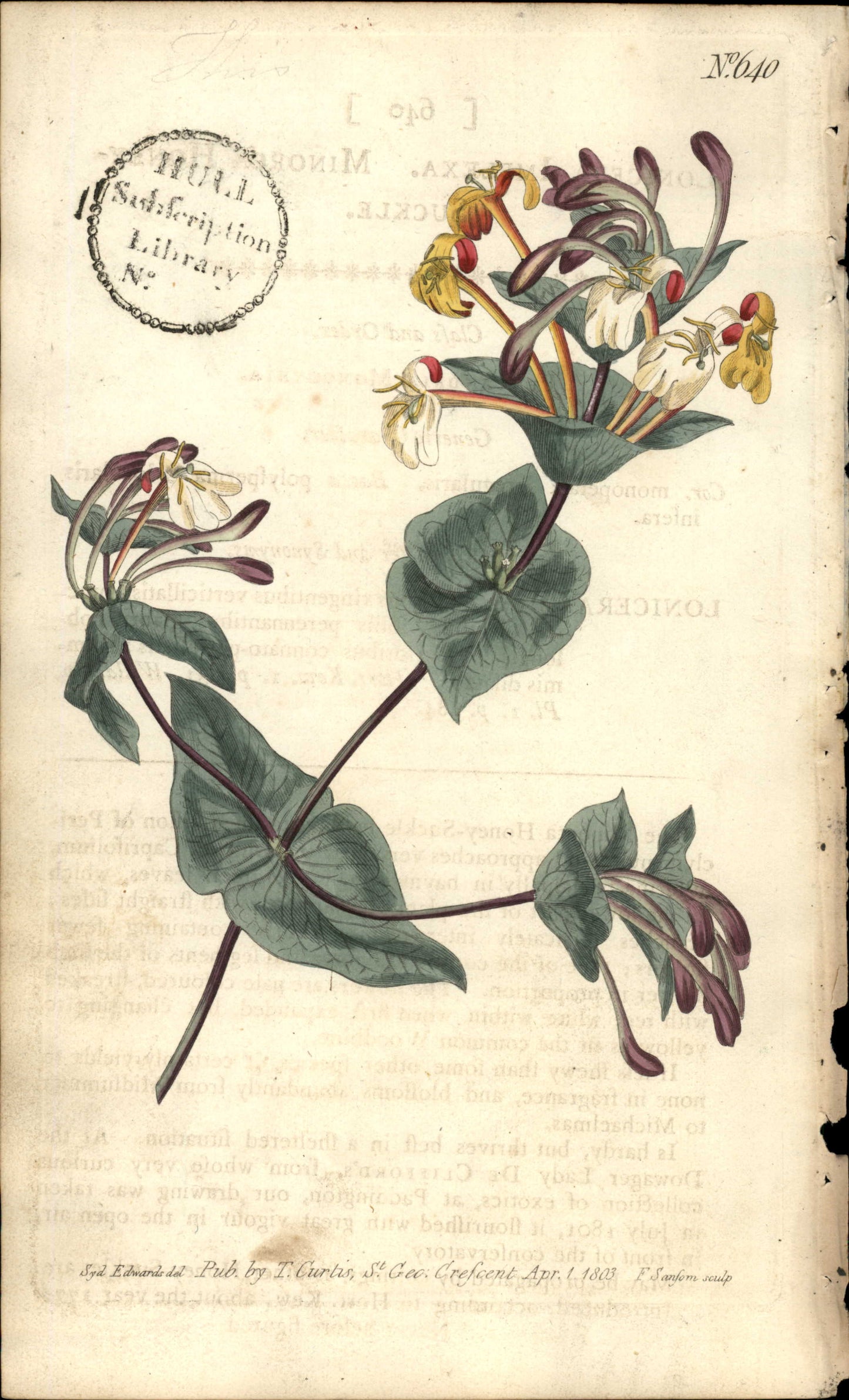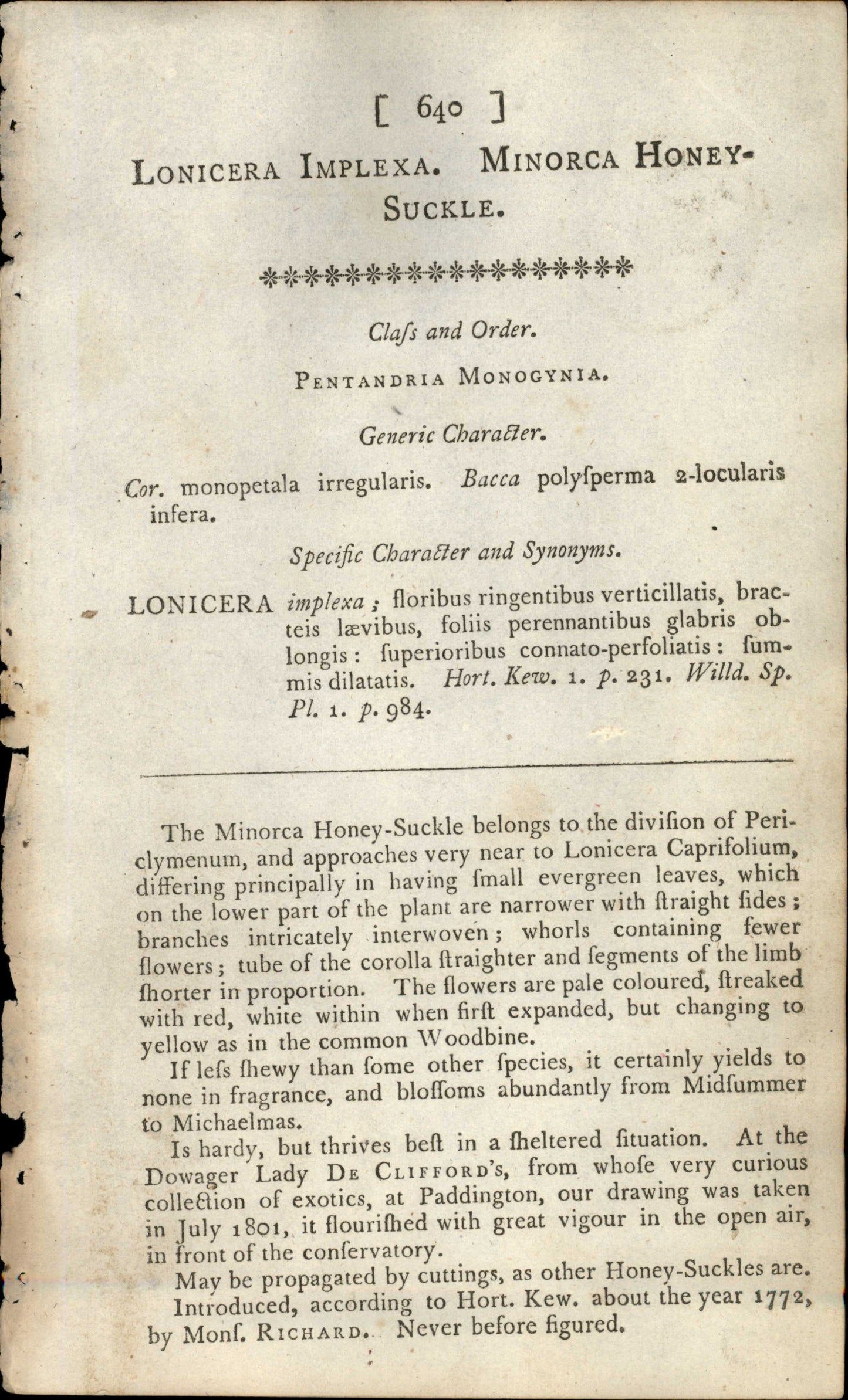Curtis Botanical Magazine
Plate 640 - Pentandria Monogynia
Plate 640 - Pentandria Monogynia
Couldn't load pickup availability
Plate 640
Classification: PENTANDRIA MONOGYNIA
Flowering Period: May - July
Publication Date: Jul 1801
Description:
Botanical Description
Minorca Honey-Suckle belongs to the divifion of Peri- clymenum, and approaches very near to Lonicera Caprifolium, differing principally in having fmall evergreen leaves, which on the lower part of the plant are narrower with ftraight fides; branches intricately interwoven; whorls containing fewer flowers; tube of the corolla ftraighter and fegments of the limb shorter in proportion. The flowers are pale coloured, ftreaked with red, white within when firft expanded, but changing to yellow as in the common Woodbine. If lefs showy than some other species, it certainly yields to none in fragrance, and blossoms abundantly from Midfummer to Michaelmas. Is hardy, but thrives beft in a fheltered fituation. At the Dowager Lady DE CLIFFORD's, from whofe very curious collection of exotics, at Paddington, our drawing was taken in July 1801, it flourished with great vigour in the open air, in front of the confervatory. May be propagated by cuttings, as other Honey-Suckles are. Introduced, according to Hort. Kew. about the year 1772, by Monf. RICHARD. Never before figured. --- CBM-ToList-640t.
Complete Botanical Text (Cleaned)
[640] LONICERA IMPLEXA.
MINORCA HONEY- *** Suckle. ************* Class and Order.
PENTANDRIA MONOGYNIA.
Generic Character.
Cor. monopetala irregularis.
Bacca polysperma 2-locularis infera. specific Character and synonyms.
LONICERA implexa; floribus ringentibus verticillatis, bract- teis lævibus, soliis perennantibus glabris ob- longis superioribus connato-persoliatis: fum- mis dilatatis.
Hort.
Kew. 1. p. 231.
Willd. sp.
Pl. 1. p. 984.
The Minorca Honey-Suckle belongs to the divifion of Peri- clymenum, and approaches very near to Lonicera Caprisolium, differing principally in having fmall evergreen leaves, which on the lower part of the plant are narrower with straight fides; branches intricately interwoven; whorls containing fewer flowers; tube of the corolla straighter and segments of the limb shorter in proportion.
The flowers are pale coloured, ftreaked with red, white within when first expanded, but changing to yellow as in the common Woodbine.
If less showy than some other species, it certainly yields to none in fragrance, and blossoms abundantly from Midsummer to Michaelmas.
Is hardy, but thrives best in a sheltered situation.
At the Dowager Lady DE CLIFFORD's, from whofe very curious collection of exotics, at Paddington, our drawing was taken in July 1801, it flourished with great vigour in the open air, in front of the conservatory.
May be propagated by cuttings, as other Honey-Suckles are.
Introduced, according to Hort.
Kew. about the year 1772, by Monf.
RICHARD.
Never before figured
Raw OCR Text (Original)
[640] LONICERA IMPLEXA. MINORCA HONEY- *** Suckle. ************* Class and Order. PENTANDRIA MONOGYNIA. Generic Character. Cor. monopetala irregularis. Bacca polysperma 2-locularis infera. specific Character and synonyms. LONICERA implexa; floribus ringentibus verticillatis, bract- teis lævibus, soliis perennantibus glabris ob- longis superioribus connato-persoliatis: fum- mis dilatatis. Hort. Kew. 1. p. 231. Willd. sp. Pl. 1. p. 984. The Minorca Honey-Suckle belongs to the divifion of Peri- clymenum, and approaches very near to Lonicera Caprisolium, differing principally in having fmall evergreen leaves, which on the lower part of the plant are narrower with straight fides; branches intricately interwoven; whorls containing fewer flowers; tube of the corolla straighter and segments of the limb shorter in proportion. The flowers are pale coloured, ftreaked with red, white within when first expanded, but changing to yellow as in the common Woodbine. If less showy than some other species, it certainly yields to none in fragrance, and blossoms abundantly from Midsummer to Michaelmas. Is hardy, but thrives best in a sheltered situation. At the Dowager Lady DE CLIFFORD's, from whofe very curious collection of exotics, at Paddington, our drawing was taken in July 1801, it flourished with great vigour in the open air, in front of the conservatory. May be propagated by cuttings, as other Honey-Suckles are. Introduced, according to Hort. Kew. about the year 1772, by Monf. RICHARD. Never before figured.
Original botanical print from Curtis's Botanical Magazine
Share





